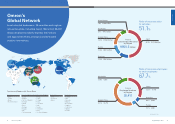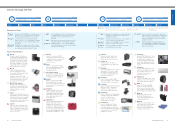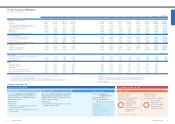Omron 2013 Annual Report Download - page 19
Download and view the complete annual report
Please find page 19 of the 2013 Omron annual report below. You can navigate through the pages in the report by either clicking on the pages listed below, or by using the keyword search tool below to find specific information within the annual report.
34 Omron Corporation Integrated Report 2013 35
Where We're Headed
on couches. Also, nebulizers are used to treat colds
or nasal infl ammation in addition to asthma.
In this way, the usage environments for our
products differ from country to country.
Importance of Downstream
Management
— Specially, what product strategies
have you envisioned for emerging
countries?
Ozeki: First, we will introduce
products into China, which is a massive
market with large numbers of potential users. In
2012, we launched an oxygen generator for people
with COPD in China. As such, our initial goal will be
to expand sales in this market, targeting substantial
sales volumes, while simultaneously acquiring sales
knowledge. Next, we will apply this experience to
India, Bangladesh, and other countries.
Umeda: In the future, we will utilize Omron’s techno-
logical prowess to provide these markets with lower-
priced products. If we are to expand sales of
nebulizers, which until recently could only be bought
by the wealthy, among the middle class, we must
provide responses to the unaddressed needs of
people in the middle class and then reduce the price
of these responses. In this endeavor, we will fashion
products that accurately respond to the needs of
emerging countries by taking advantage of the tech-
nologies we have accumulated through the process
of creating products for developed countries.
Ozeki: In regard to sales strategies, the method
of supplying products to local sales agents and
then leaving the act of selling up to them is an
obsolete way of developing overseas operations.
develop products that are easier for patients to use
in recognition of this fact led to the creation of prod-
ucts customers can use while lying down.
In this way, imagining the actual circumstances
under which customers use our products is of ex-
treme importance in the product planning process.
After conducting usage investigations in various
countries, we learned that there were cases in
which proper treatment methods are not well
known and cases in which our products were being
used in incorrect manners.
Ozeki: Usage circumstances are an important point
of focus even with regard to sales.
In other words, simply introducing products that
we developed for Japan, Europe, or the United
States into the markets of emerging countries does
not always work. In developed countries, users tend
to prefer products that are smaller, lighter, and more
comfortable to use, even if they might be more
expensive. However, in emerging countries, the
primary concern is price, with the second concern
being ease of use. Talking to customers in Asia, we
were surprised to hear how their opinions with re-
gard to the weight and noisiness of products differed
from that of customers in Japan. In some Asian
countries, a heavy product is seen as sturdy and
therefore reliable, and a loud product is perceived as
more effective.
— Are there any other examples of differences
between developed and emerging countries?
Umeda: In Japan, a user would generally place
their nebulizer on a table and use it while sitting in a
chair. However, our investigations in Brazil and India
show that it is common to use nebulizers in bed or
Healthcare Business (HCB) and Emerging Countries
Core Theme
2
Rapid Rise in Asthma and COPD
Sufferers in Emerging Countries
— Looking at the particulate matter 2.5 (PM2.5) issue
in China, it would seem that many emerging coun-
tries are facing air pollution issues, and these issues
are growing ever more serious. Is this the case?
Ozeki: Yes. The air pollution issues in emerging
countries are serious, and not only limited to China.
In conjunction with development, chronic malady is
starting to replace infectious disease as the most
common ailment faced by the populous. In China,
this situation is being compounded by a rise in
smoking*1, and we are noticing a rapid increase in
the number of people with chronic obstructive
pulmonary disease (COPD)*2 as a result. In this
manner, environmental pollution and the trend
regarding respiratory diseases are driving a sub-
stantial increase in the number of people suffering
from asthma and COPD.
— Going forward, how do you plan to address the
social needs created by this situation?
Umeda: I believe we can provide a viable option for
addressing this situation in the form of the nebuliz-
ers. They are a type of medical device that enables
vaporized medicines to be inhaled by sufferers of
asthma and other respiratory diseases. There are
primarily three different types: compressor nebuliz-
ers, ultrasonic nebulizers, and mesh nebulizers.
Compressor nebulizers account for approximately
90% of the entire nebulizer market. However, as
these require liquid medicines to be converted into
a fi ne mist, they are often heavy and noisy. By re-
vising the structure of parts, Omron has success-
fully resolved this issue by creating compressor
nebulizers that are both small and quiet. As an
example of this structural revision, we modifi ed
a pump from one of our mainstay blood pressure
monitors to be used in these nebulizers.
Innovating parts in this manner helps cut costs.
Nevertheless, this was not an easy process as
using the blood pressure monitor pump placed
increased importance on the output capacity of
the atomizing unit in ensuring that the pump could
supply a suffi cient amount of medicine mist.
The development process for this atomizing unit
was conducted steadily over a long period of time.
I think Omron is a rarity among manufacturers in
the world for devoting such effort to a single unit.
Mesh nebulizers are generally smaller and quieter
than compressor nebulizers and can be used while
lying down. However, they are also more expensive
than compressor nebulizers and maintenance of
parts is more of a hassle.
*1 Rise in smoking in China: According to a survey conducted in 2012, the smoking
popu lation in China represents one-third of the total global smoking population.
Moreover, in terms of the percentage of smokers, China is No. 2 in Asia
after Indonesia.
*2 COPD: This term refers to chronic bronchitis or emphysema, which is the No. 4
leading cause of death worldwide. The main cause is smoking, with more than
90% of sufferers also being smokers.
Helping Improve the Health of
People in Emerging Countries
As society develops, social needs for means of preventing and treating illness are constantly rising.
HCB develops its operations based on the unique approach of using these needs as drivers for
advancing innovation in its business. We spoke with representatives from sales and marketing
and global product planning divisions that have engagements in emerging countries in Asia.
Toru Ozeki
Executive Offi cer
and Senior General Manager
in charge of the Sales and
Marketing HQ–Asia
OMRON HEALTHCARE Co., Ltd.
Masahiro Umeda
Manager,
Group Leader,
Product Planning Strategy HQ
OMRON HEALTHCARE Co., Ltd.
Importance of Imagining
Usage Situations
— It would seem that the ability to use mesh
nebulizers while lying down would be a signifi cant
advantage in terms of usage.
Umeda: When nebulizers are used by small chil-
dren, it is common for them to be watched over by
their mothers. However, there are those mothers
who want to have their children use nebulizers while
lying down should symptoms permit. Our desire to
Oxygen generators for
Chinese market
Mesh nebulizer
2
2
2
Core Them
C
C
o
r
e
e
T
T
h
h
e
em
C
C
o
r
e
e
T
T
h
h
e
em
C
C
T
T
h
h
2
2
2
2
2
2
2
2
2
2
2
2
2
2
2
2
2
2
2
2
2
2
2
2
me
m
e
e
me
m
m
m
m
Compressor nebulizer
























